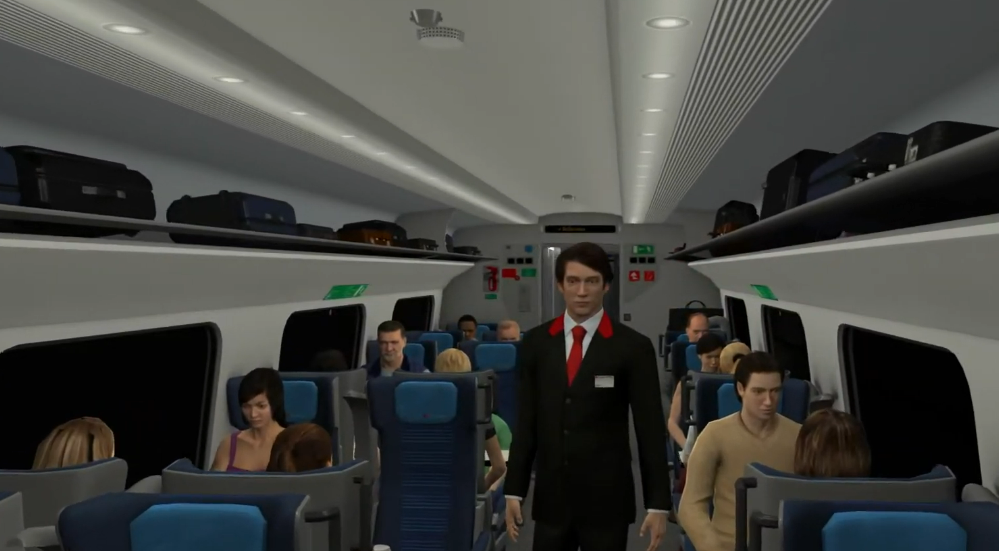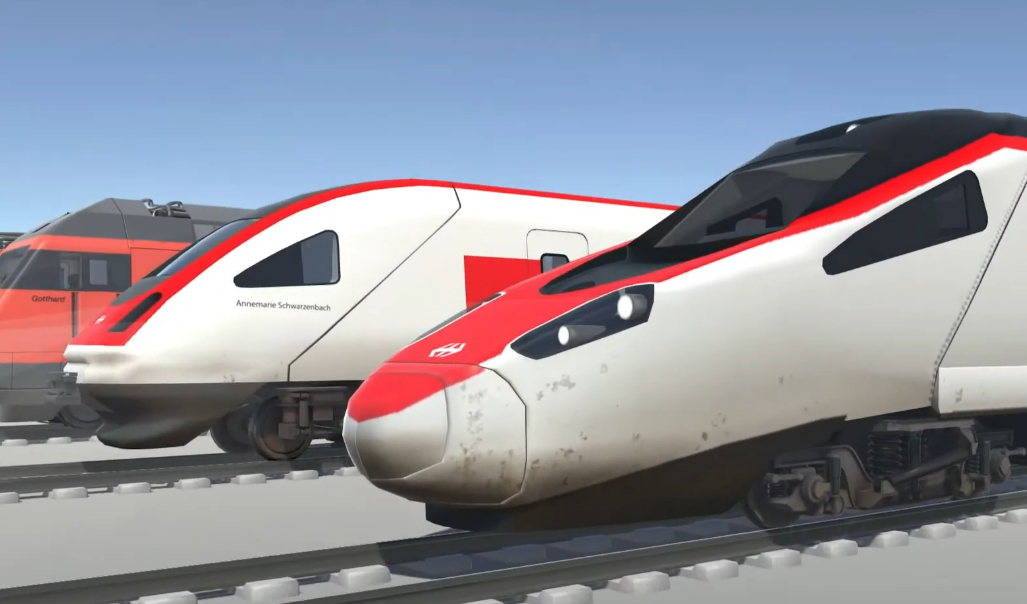Training in the virtual Gotthard Base Tunnel
To achieve maximum safety for passengers and staff, the Swiss Federal Railways (SBB) had the challenging task of providing actionable training for some 4,000 people in 200 different roles, from train crews to control center personnel to preservation and crisis intervention staff. And this in an environment that is hardly accessible for training.

3DSim@GBT by TriCAT GmbH is a realistic virtual replica of the Swiss Gotthard Base Tunnel (GBT), the world’s longest rail tunnel at 57 kilometers, which opened in summer 2016. In the simulation, the entire tunnel landscape of the GBT and all trains used in tunnel operations are available in the form of an avatar-based and AI-supported virtual 3D world. The target group is employees of the Swiss Federal Railways (SBB).

The scope of application ranges from learning route knowledge to strategies for emergency management, such as in the event of a fire, to simulated mass evacuation of entire trains. A complex scenario and sequence editor enables SBB trainers to develop any training scenarios without requiring programming skills.
PROJECT GOAL | CHALLENGE
Actionable training of around 4,000 people in an avatar-based and AI-supported virtual 3D world of the entire tunnel landscape as well as in all trains used in tunnel operations
Acquisition of demonstrable action competence for safe operation (route knowledge , strategies for emergency management e.g. in case of fire, virtual execution of simulated mass evacuation of entire trains).
Development of a complex scenario and sequence editor for the operation of SBB trainers without programming knowledge
TARGET GROUP
Employees of the Swiss Federal Railways (SBB) from train staff, employees receiving, crisis intervention staff, staff in the control rooms.
REALIZATION
Development of a virtual 3D simulation environment for realistic individual training and complex team exercises
DETAILS
- Realization of the complete tunnel landscape as an interactive 3D action environment
- Implementation of all central functionaries or training roles as controllable and actionable avatars
- Control of several hundred passengers up to mass evacuation via AI (artificial intelligence)
- Integration of all components to a realistic PC-based multiplayer simulation
- Extensive trainer tools for exercise control, monitoring and debriefing
- Development of an authoring tool for the independent design of training scenarios by the customer
AWARDS for 3DSim@GBT



Interview with Michael Bruderer
Head of Educational Development at SBB and initiator, conceptual father and implementer of the 3DSim@GBT project.

Like real life
The aim of such realistic scenarios is to give the professionals confidence to act. Michael Bruderer explains, “Employees should get a feel for how different scenarios play out and the impact of their actions.” When mistakes happen in communication, it can be devastating. If a fire is not extinguished properly, it will continue to burn. In the simulation just as in real life.
Another advantage of simulation is that employees in the virtual learning world are not bound to the roles they take on in real life. “This gives employees the opportunity to experience different situations from different perspectives.” The change in perspective is also made possible after the fact by recording each scenario. In this way, those involved can view the exercise from a colleague’s point of view or from a “bird’s eye view,” for example. This is intended to promote self-reflection. It’s easier to gain insight on your own, Bruderer said. “When you look at a situation from the outside, it’s a completely different experience than when you’re in the middle of it yourself. This change of perspective goes beyond the possibilities of a real staged exercise and greatly supports learning.” In order to specifically process what has been learned, each simulation is followed by a debriefing.
As an evaluation tool, each learning situation is followed by an oral feedback session. In addition, SBB had the participants fill out written feedback forms between two and four weeks after the training. The evaluation was supplemented after a further two to four weeks with oral surveys of randomly selected participants in the form of random samples. “The evaluations showed that the application and the associated modern learning setting met with great enthusiasm and acceptance from all participants,” says Bruderer. The training participants had particularly appreciated the ability to experience the processes together with the other roles and the resulting high learning transfer. “Feedback from everyday work also indicated a fundamental increase in the participants’ confidence in their professional practice – even beyond the situations trained in the simulation.”
Actually impossible
Right from the start, the project was characterized by time limits with zero tolerance: “The commissioning of the Gotthard Base Tunnel generated an absolutely binding end date for the project,” says Bruderer. SBB had invested 24 months for the rough and detailed design of the 3DSim@GBT – there were no more time resources available. “I know: this is actually impossible,” says Bruderer about the implementation of his innovation project within such a time-limited framework. “The 24 months certainly do not represent a reference value for such a project. Rather, they illustrate what the momentum of a century-long construction can generate along the way for peak performance.” In February 2016, process training was successfully launched on schedule.
When choosing a provider for the training project, SBB was particularly interested in high didactic quality, says Bruderer. “Or, to put it the other way around, the provider must not be solely technology-driven.” Technology had a purely supporting and thus subordinate role, he said. Another important criterion in the selection of the provider, he said, was that it should be able to show various reference projects. “And finally, a key success factor is that experience is available in terms of iterative and agile development processes.”
The virtual learning world was implemented by the German provider Tricat GmbH. Due to the expected project volume of two to three million Swiss francs, SBB had to determine the provider by means of a WTO tender as part of a public procurement procedure. “Tricat finally submitted the qualitatively best offer to us. As a result, they were awarded the contract in accordance with the applicable legal guidelines.”
Virtual versus real?
Will training in virtual space soon displace real exercises or classic approaches to learning? According to Bruderer: No. Training in virtual spaces should primarily have a supplementary character. “In most cases, they cannot replace real-life experience that is relevant to learning,” says Bruderer. Although the use of modern training technologies is a matter of course in today’s era of digitalization, it is not necessarily useful for every educational measure as well, he said. “Learning is and remains a highly individual process that is always social and strongly influenced by external factors.”
In SBB’s in-company training, there are also measures for which, from a didactic point of view, the best training quality can be achieved with traditional face-to-face instruction, based on content, target group and framework conditions. “Likewise, the same argumentation results in potentials for fully virtualized educational measures or mixed forms of different characteristics.” SBB also did not rely solely on learning in the virtual world for the training program in the context of the Gotthard Base Tunnel. Rather, training in virtual space was part of a module for train crews. SBB has redesigned and developed around 90 different training products for training and development in connection with the Gotthard Base Tunnel, which required around 20,000 training days to be completed by fall 2016.
The training innovation has caused a stir throughout Europe – in concrete terms, Bruderer notices this in invitations to training fairs and congresses as well as expressions of interest from various other companies. In the meantime, the 3DSim@GBT project has also received several awards.
“The technology has never before been used in this complexity and form anywhere else,” says Bruderer, explaining the great interest. Even apart from fame and glory, he draws a positive conclusion to the project: “From a didactic point of view, the application exceeds expectations and opens up great potential for our in-company training within SBB.”


